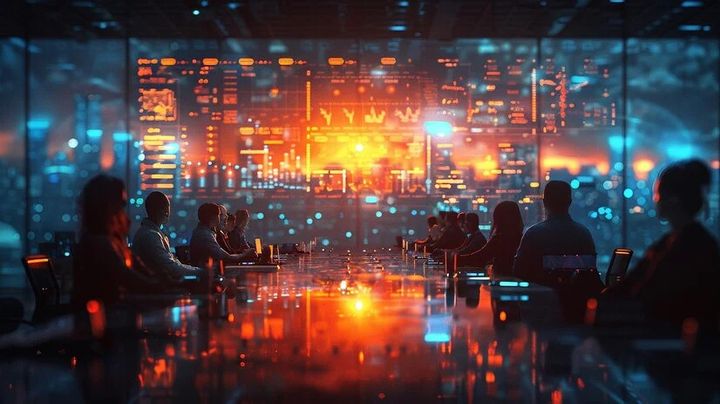
Tips and Advice for Integrating Immersive Tech into Your Corporate Events
Immersive technology refers to a group of technologies—primarily Virtual Reality (VR), Augmented Reality (AR), and Mixed Reality (MR)—that create or extend reality through digital means. In the context of corporate events, these tools are used to build engaging, interactive, and memorable experiences for attendees. The goal is to move beyond the traditional format of passive presentations and static booths, transforming events into dynamic environments that captivate and hold an audience's attention.
The Importance of Immersive Tech Today

In 2025, immersive technology is more than a novelty; it is a strategic asset for event organizers. Its integration addresses key challenges faced by the events industry, from low attendee engagement to the struggle of creating memorable experiences that yield a strong return on investment.
Who It Affects
Event Planners and Organizers: These professionals can leverage immersive technology to design unique, high-impact events that attract attendees and sponsors.
Corporate Marketing Teams: Marketers use immersive tech to create powerful brand experiences that communicate key messages in a dynamic, lasting way.
Human Resources Departments: For corporate training events, VR and AR are used to create realistic and safe simulations for skills development, from a virtual factory floor to a customer service scenario.
Conference and Event Attendees: Participants benefit from a more engaging experience that offers new ways to network, learn, and interact with content, moving from being passive listeners to active participants.
Problems It Solves
Low Engagement and Participation: Immersive technology can transform a standard event into a highly interactive one. For example, a VR experience can allow attendees to explore a virtual version of a new product, or an AR app can overlay digital information onto a physical trade show booth. This turns passive viewing into active exploration and interaction, combating attendee boredom.
Lack of Memorability: Humans are more likely to remember experiences they are emotionally or physically engaged in. An immersive event leaves a strong, lasting impression, ensuring that the brand message and key takeaways are retained long after the event concludes.
Accessibility and Reach: In an era of hybrid events, immersive technology is a key tool for creating a sense of presence for remote attendees. A virtual event in the metaverse can allow people from across the globe to network and interact as if they were in the same physical space, breaking down geographical barriers and expanding an event's reach.
Measuring Impact: Immersive technology can collect valuable data on attendee behavior. By tracking what attendees interact with in a virtual environment, event organizers can gain a deeper understanding of what content is most engaging, which can be used to inform future event strategies and measure a clear return on interaction.
Recent Updates and Trends
The immersive technology landscape for corporate events is evolving quickly, with several key trends shaping the industry in late 2024 and mid-2025.
AI-Powered Personalization: Artificial Intelligence (AI) is being integrated into immersive experiences to make them highly personalized. AI algorithms can analyze user preferences and behaviors in a virtual environment to dynamically adjust content, making each attendee's journey unique. For example, an AI-powered virtual assistant can guide a user to the most relevant content or networking opportunities based on their profile.
More Accessible and Affordable Hardware: The development of more lightweight, standalone VR headsets and the widespread availability of AR-enabled smartphones have made immersive experiences more accessible. This eliminates the need for expensive, high-end equipment and makes it feasible for a wider range of companies to integrate this technology into their events.
The Rise of Digital Twins: A growing trend involves the creation of a "digital twin"—a virtual replica of a real-world event venue or physical space. This allows for seamless hybrid events where both in-person and remote attendees can interact in a shared, immersive environment. A digital twin of a factory floor, for instance, can be used for a virtual tour that is accessible to a global audience.
Haptic and Sensory Integration: Beyond just visual and audio, there is a push to make immersive experiences more multi-sensory. While still an emerging field, developments in haptic gloves and vests allow users to "feel" virtual objects and vibrations, adding another layer of realism and engagement to training simulations and product demonstrations.
Laws and Policies
As immersive technology becomes more widespread, it is subject to a growing body of regulations, particularly concerning data privacy and accessibility.
Data Privacy Regulations: Immersive technologies, especially VR and AR, can collect vast amounts of data, including biometric information from eye and head movements, and spatial data from a user's surroundings. In India, like in many other countries, data protection and privacy laws are becoming increasingly strict. Event organizers must ensure they have explicit consent from attendees to collect this data and have clear policies on how it will be stored, used, and protected. Compliance with these laws is crucial to building trust with attendees and avoiding legal issues.
Accessibility Laws: As immersive technology becomes a key component of events, there is a growing need to ensure it is accessible to people with disabilities. Event organizers may need to consider how to make VR experiences usable for individuals with motion sickness or mobility issues, or how to provide audio descriptions for visually impaired users in a virtual environment. Compliance with accessibility standards ensures that events are inclusive and open to all.
Government Initiatives: The Government of India has been actively promoting the Animation, Visual Effects, Gaming, and Comics (AVGC) sector, which includes immersive technologies. Initiatives and policies aimed at fostering innovation in this space can provide a supportive ecosystem for companies that create immersive experiences for corporate events. This includes government-backed incubators, funding opportunities, and participation in global tech showcases to promote Indian talent.
Tools and Resources
Integrating immersive technology into a corporate event can be a complex process. Fortunately, there are many tools and resources available to help event planners navigate it.
VR/AR Hardware and Software: The starting point is the hardware. Devices like the Meta Quest series and Apple Vision Pro are leading the market in terms of user-friendliness and accessibility. For creating AR experiences, software development kits (SDKs) like Apple's ARKit and Google's ARCore are the industry standards.
Event Technology and Metaverse Platforms: A variety of event platforms now offer built-in support for immersive experiences. These platforms provide a digital framework for building a virtual event, with features for networking, content delivery, and interactive booths. They often integrate with popular immersive technology content.
Content Creation and Design Software: To build a custom immersive experience, professionals use software like Unity and Unreal Engine. These powerful tools allow developers to create highly detailed and realistic 3D environments, virtual objects, and interactive elements.
Specialized Agencies and Professional Services: For companies without an in-house team, working with an agency that specializes in immersive experiences for corporate events can be the most effective solution. These agencies handle the entire process, from conceptualization and content creation to on-site technical support.
Frequently Asked Questions
Is immersive technology too expensive for a corporate event?
While custom immersive experiences can be a significant investment, the cost is decreasing as technology becomes more accessible. Many companies now offer more affordable, modular solutions. The focus should be on the return on investment (ROI), which can be measured through increased engagement, lead generation, and brand memorability.
How can I measure the ROI of an immersive event?
Measuring the ROI of an immersive event goes beyond simple revenue. You can track metrics such as attendee engagement rates (e.g., time spent in a virtual booth), lead conversions from virtual meetings, social media buzz, and post-event survey data on brand perception and knowledge retention.
What is the difference between AR and VR for events?
Virtual Reality (VR) creates a completely new, artificial environment that a user enters using a headset. It is ideal for virtual keynotes, training simulations, and exploring a product in a new way. Augmented Reality (AR) overlays digital information and objects onto the real world, typically viewed through a smartphone or tablet. It is excellent for interactive trade show booths, where a user can point their phone at a product to see a 3D model or a video.
Do attendees need special training to use this technology?
For most modern immersive experiences, the learning curve is very low. Consumer-friendly VR headsets and AR apps are designed to be intuitive. For more complex experiences, like a training simulation, a brief on-site or virtual tutorial is typically provided to ensure all attendees can participate effectively.
Conclusion
Integrating immersive technology into corporate events is no longer a futuristic concept; it is a current and effective strategy for creating more dynamic, engaging, and memorable experiences. By thoughtfully incorporating VR, AR, and other immersive tools, event organizers can transform a traditional event into a powerful platform for learning, networking, and brand building. While the technology continues to evolve, its core value remains clear: it is a powerful way to captivate an audience and deliver a message that resonates long after the event has concluded.










